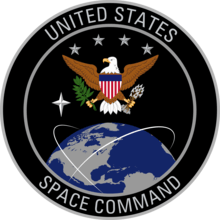United States Army Space and Missile Defense Command
The United States Army Space and Missile Defense Command (USASMDC) is an Army Service Component Command (ASCC) of the United States Army. The command was established in 1997. The current USASMDC commander is Lieutenant General Daniel L. Karbler with Senior Enlisted Advisor Command Sergeant Major Finis A. Dodson.
| Space and Missile Defense Command | |
|---|---|
 Shoulder Sleeve Insignia | |
| Active | 1 October 1997 – present |
| Country | |
| Branch | |
| Part of | |
| Headquarters | Redstone Arsenal, Alabama, U.S. |
| Website | www |
| Commanders | |
| Current commander | Lieutenant General Daniel L. Karbler[1] |
| Insignia | |
| Distinctive Unit Insignia |  |
The Army Space Command (ARSPACE) stood up in April 1988 as a field operating agency of the Deputy Chief of Staff (of the Army) for Operations and Plans.[2] As the Army component of U.S. Space Command, ARSPACE was to provide the Army perspective in planning for Department of Defense space support and ensure the integration of Army requirements into joint planning for space support and "conduct planning for DoD space operations in support of Army strategic, operational and tactical missions."
A relatively small organization, it was soon put to the test. The new command was instrumental in bringing space assets to U.S. Army forces during Operation Desert Storm. Following the war, new operational missions, such as the Army Space Support Teams and the Joint Tactical Ground Stations, became key elements of the Army space program.
Organizationally however, ARSPACE remained a command, a Tables of Distribution and Allowances, or TDA, organization with offices and directorates according to mission, rather than an Army operational Table of Organization and Equipment unit. This changed on 1 May 1995. On that date, ARSPACE's Military Satellite Communications Directorate or MILSATCOM Directorate became the 1st Satellite Control, or SATCON, Battalion—the first Army battalion with an operational mission tied to space systems and capabilities.
Structure
The SMDC is made up of several components, Active Army and full-time Army National Guard, due to the 24-hour a day, 7-day a week, 365-day a year nature of SMDC's mission:[3]
- SMDC Headquarters and the Force Development Integration Center in Redstone Arsenal, Alabama
- U.S. Army Space and Missile Defense Command[3] / U.S. Army Forces Strategic Command (USASMDC/ARSTRAT)[4] located in Peterson AFB, Colorado Springs, Colorado
- 1st Space Brigade,[5] Peterson Air Force Base, Colorado
- 100th Missile Defense Brigade (GMD),[9] Schriever Air Force Base, Colorado
- 49th Missile Defense Battalion,[10] Alaska Army National Guard, Fort Greely, Alaska
- Satellite Operations Brigade[11]
- 53rd Signal Battalion (SATCON)
- Satellite Communications Directorate
- Space and Missile Defense Technical Center (SMDTC)
- Space and Missile Defense Battle Lab (SMDBL)[12]
The 117th Space Battalion has a training, readiness, and oversight (TRO) relationship with the 1st Space Brigade but is not actually part of it, as of 2018–19.
- Space and Missile Defense Acquisition Center (SMDAC) based in Huntsville, Alabama; the SMDAC comprises:
- High Energy Laser Systems Test Facility (HELSTF), at White Sands Missile Range, New Mexico.
- U.S. Army Kwajalein Atoll/Reagan Test Site (USAKA/RTS), in the Republic of the Marshall Islands and at Wake Island
- Army Space Program Office (ASPO) in Alexandria, Virginia
- Joint Land Attack Cruise Missile Defense Elevated Netted Sensors Project Office (JLENS) based in Huntsville, Alabama[13]
- Ballistic Missile Targets Joint Project Office (BMTJPO) based in Huntsville, Alabama
1st Space Brigade
The 1st Space Brigade (Provisional) was activated in May 2003, with the 1st Space Battalion, the 1st Satellite Control Battalion (later to become the 53rd Signal Battalion), and the 193rd Space Battalion (Colorado Army National Guard).[14]
The mission of 1st Space Brigade is to "conduct continuous, global space support, space control and space force enhancement operations in support of U.S. Strategic Command and Supported Combatant Commanders enabling the delivery of decisive combat power." [15]
53rd Signal Battalion (SATCON) conducts payload and transmission control of the Defense Satellite Communications System and Wideband Global Satellite Communications System constellations.[16][17]
Friendly force tracking (actually tracking both friend or foe) is one of the basic functions of the SMDC.[3]
History
On 27 Sept. 1974, at the Missile Site Radar Complex near Nekoma, North Dakota, and at the Ballistic Missile Defense Center at NORAD, Cheyenne Mountain, the Safeguard System facilities were officially transferred to the U.S. Army Ballistic Missile Defense Systems Command after a four and one-half-year construction project by 10 companies.[18]
Joint Center of Excellence
The Joint Ballistic Missile Defense Education and Training Center (JBMDETC) is now a Joint Center of Excellence.[19] JBMDETC is operated by the Joint Functional Component Command for Integrated Missile Defense (JFCC IMD). United States Strategic Command's JFCC IMD is located at Schriever Air Force Base. Both Space and Missile Defense Command (SMDC) and JFCC IMD are service components of United States Strategic Command.
Air and missile defense (priority)
Air and missile defense is a modernization priority of United States Army Futures Command, an ACOM.[20] The Air and missile defense CFT[21][22] is tasked with modernization of materiel for Air and Missile defense.[23][24] Targeted areas currently include:
The LCMC (part of ASA(ALT)), the United States Army Aviation and Missile Command (AMCOM) is an associated unit of Aviation and Missile Research, Development, and Engineering Center (AMRDEC) Redstone Arsenal. AMRDEC is now part of U.S. Army Futures Command, as is the Air and missile defense CFT. The LCMC is responsible for materiel sustainment; AMRDEC and the respective CFTs work to modernize aircraft for the Aviation COE, and missiles for SMDC.
A Program executive officer (PEO) works with the Army Futures Command CFTs to move materiel into production. Vendors for Lower Tier Air and Missile Defense Sensor (LTAMDS) were downselected to two competitors in 2017, and 2018. The award to replace the Patriot radar is slated for 2023.[30]
The Space and Missile Defense program at West Point
After the 2001 Space Commission identified the need for Space cadre in the DoD, the United States Military Academy (USMA) initiated an SMD program.[31]
Commanders 1997–2019
- LTG Daniel L. Karbler, 6 December 2019 – present
- LTG James Dickinson, 5 January 2017 – 5 December 2019
- LTG David L. Mann, August 2013 – January 5, 2017
- LTG Richard P. Formica, December 2010 – August 2013
- LTG Kevin T. Campbell, December 2006 – December 2010
- LTG Larry J. Dodgen, December 2003 – December 2006
- Lieutenant General Joseph M. Cosumano, Jr.: from April 2001 – December 2003[32]
- Brigadier General John M. Urias: March 2001 – April 2001
- Lieutenant General John Costello: October 1998 – March 2001
- Colonel (P) Steven W. Flohr: August – October 1998, Interim Commander
- Lieutenant General Edward G. Anderson III: October 1997 – August 1998 Commander, USASSDC, October 1996 – September 1997
See also
Joint Functional Component Command for Integrated Missile Defense Comparable organizations
- Naval Network Warfare Command (U.S. Navy)
- Air Force Space Command (U.S. Air Force)
References
- Ronald Bailey (USASMDC) (November 26, 2019) Karbler confirmed to lead U.S. Army Space and Missile Defense Command
- "SMDC History: 20th anniversary of the creation of 1st SATCON Battalion". army.mil. Retrieved 25 October 2017.
- Dottie White (August 17, 2018) SMDC senior leader discusses his career path, unique role of National Guard in Command's mission
- Sgt. Zachary Sheely (SMDC/ARSTRAT) (December 11, 2017) Nine Soldiers graduate ICBM defense course
- Dottie White (July 17, 2018) 1st Space Brigade welcomes new commander
- Meet your Army: Chief trains Soldiers to detect missiles, Accessed 2016-09-06
- SMDC/ARSTRAT Public Affairs Office (October 22, 2018) Early missile warning unit passes evaluation with 99 percent Joint Tactical Ground Station (JTaGS), Osan AB
- White, Dottie K (17 October 2017). "Army activates 2nd Space Battalion". US Army. Retrieved 5 July 2018.
- SGT Benjamin Crane, 100th Missile Defense Brigade (GMD) Public Affairs (15 September 2011) Missile defense exercise spans globe
- Carlson III, Staff Sgt. Jack W. (18 February 2010). "This week at the 49th Missile Defense BN". US Army. Retrieved 5 July 2018.
- U.S. Army Satellite Operations Brigade
- Sharon Watkins Lang, USASMDC/ARSTRAT Command Historian (February 16, 2016) SMDC History: SMDC creates first non-TRADOC Battle Lab 1997–2015
- Associated Press, "U.S. Army tests new dirigible craft to detect cruise missiles", 20 April 2010.
- "The Eagle" (PDF). May 2003. Archived from the original (PDF) on 18 February 2013.
- (11 April 2003) SMDC activates 1st Space Brigade (Provisional)
- Dottie White (June 11, 2018) 53rd Signal Battalion conducts change of command
- Sean Kimmons, Army News Service (March 18, 2019) Satellite launch enhances comms for Army missions
- Sharon Watkins Lang (SMDC/ARSTRAT Command Historian) (September 27, 2018) SMDC History: Army accepts Safeguard System
- Frank Saffen (JFCC IMD) (October 2, 2018) DoD certifies first Joint Center of Excellence
- Sydney J. Freeberg, Jr. (28 May 2019) Beyond INF: An Affordable Arsenal Of Long-Range Missiles? INF Treaty likely to expire in August 2019
- Air and missile defense CFT (14 March 2018) Air and Missile Defense
- Army Directive 2017–24 (Cross-Functional Team Pilot In Support of Materiel Development)
- David Vergun, Defense.gov (February 22, 2019) DOD official describes missile defense strategy
- Loren Thompson (3 October 2019) Pentagon's Next-Gen Missile Defense Plan Could Leave U.S. Poorly Protected For Years
- Sydney J. Freeberg, Jr. (January 26, 2018) $86,000 + 5,600 MPH = Hyper Velocity Missile Defense
- Sydney J. Freeberg, Jr. (22 August 2018) Why Hypersonics Are No. 1
- Joe Lacdan (October 16, 2018) The Army joins the Air Force, Navy in attempt to develop hypersonic weaponry
- Samantha Hill (SMDC/ARSTRAT) (February 25, 2019) Dickinson highlights key developments in missile development and space SHORAD
- (19 March 2018) Air and missile defense CFT pursuing 'layered and tiered approach'
- Rich Abott (10/09/2018) Lockheed Martin And Raytheon Advance In Patriot Radar Replacement
- Jason B. Cutshaw, SMDC/ARSTRAT (23 March 2017). "SMDC partners with military academy to develop future space officers".
- "Conclusions and Appendicies" (PDF).
External links
- Official website
- "Army Space & Missile Defense Command". GlobalSecurity.org.
- Future Warfare Preparation: US Army Space & Missile Defense Command – animated dramatization of various missile defense scenarios (YouTube video made by Delta Research Inc for SMDC)

